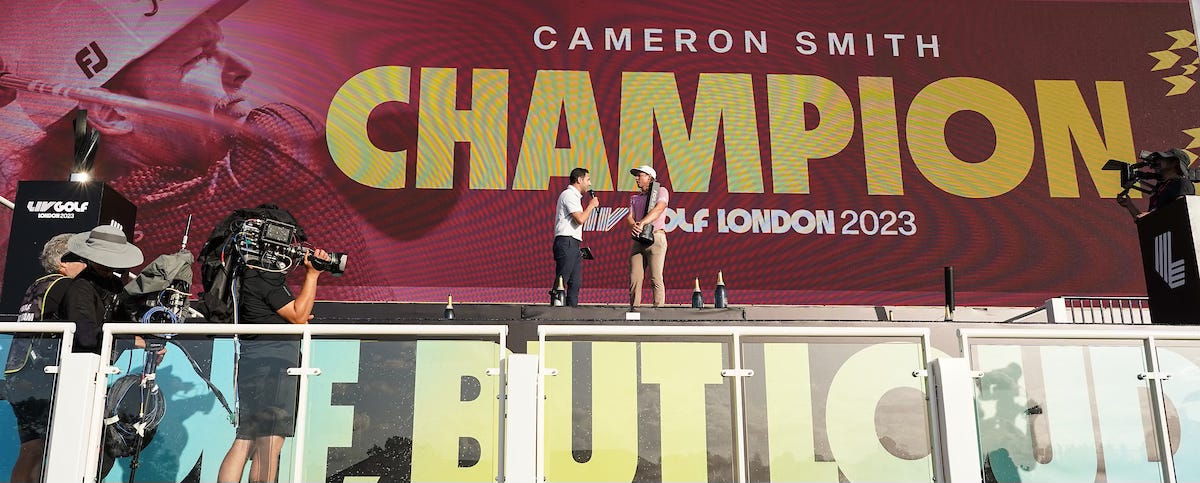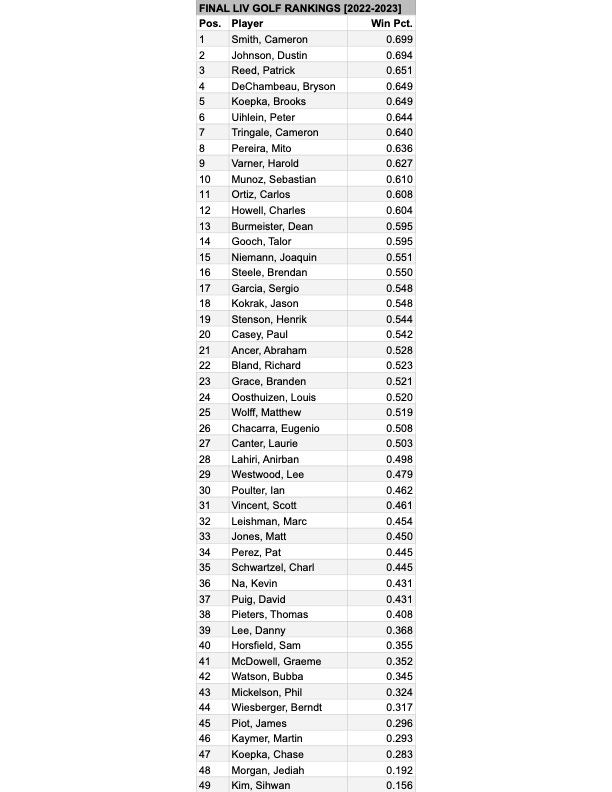LIV Golf players want rankings? Well, here you go
The First Call's Gary Van Sickle has been crunching numbers for his LIV Golf Rankings and while the No. 1 player is not surprising, other results were telling
Editor’s note: Every other Wednesday — in addition to your regular Saturday edition — Gary Van Sickle will share his stories and opinions about golf as a regular contributor to The First Call. Van Sickle has covered more than 200 majors for golf publications such as Golf World and Sports Illustrated, so he knows a little something about the game.
Perhaps — and we don’t understand why — you just want to read Van Sickle’s columns and not get the Saturday edition. To do that, follow these instructions.
Missed his debut column? No worries, click here.
There’s a good chance you didn’t pay any attention whatsoever to the artists known as LIV Golf.
No problem, I did it for you. By creating my own proprietary LIV Golf Rankings, I have spent two years tracking who’s hot, who’s not and who’s just hanging out and feeding at the money trough.
We can save the debate for another time on whether LIV Golf has any redeeming entertainment value and if you give a rat’s behind. That’s a different story.
The LIV Golf players whine that they don’t get ranking points. Well, they have rankings. I did them.

LIV Golf’s second season is over and my LIV Golf Rankings cover the circuit’s entire two seasons without bias. The rankings are based simply on how many players each competitor finished ahead of, behind or tied in each 48-man LIV Golf event. When Brooks Koepka won the final event at Jeddah, for instance, he had a 47-0-0 mark that week. A player in a three-way tie for third would be credited with a 43-2-2 mark.
My final LIV rankings cover each event from both seasons. Since some LIV players competed in the four major championships, I also included those results. They carried more weight, obviously, because the fields were bigger. I capped the field sizes of the PGA Championship, U.S. Open and British Open to match the field size at the Masters (86 players this year), so all four majors would be of equal value and yes, they therefore are worth about twice as much as each LIV Golf event.
Each player’s won-loss-tie total is converted into a winning percentage. Here’s an example: Bryson DeChambeau’s two-year mark is 856-449-61, a win percentage of .649.
DeChambeau is not the No. 1 player in the current LIV Golf Rankings. Neither is Brooks Koepka or Talor Gooch. Who is? Read on, here are my Cliff Notes version of the rankings …
The 1 and only
While Johnson held the top spot in the Van Sickle LIV Golf Rankings for a majority of the circuit’s first two seasons, Aussie Cameron Smith finished as No. 1. His final batting average, to borrow a baseball term, was .699, slightly better than Johnson at .694. Yeah, the day of the .700 hitter is probably over. Smith, best known for his 2022 British Open win at the Old Course and his counter-culture mullet, held on to No. 1 despite a late-season slump. After he won a second LIV Golf title in London last summer, he finished 37th, 32nd and 24th in the last three events, a .326 average. In 12 LIV events this year, though, Smith was ninth or better six times.
The snubmarine sandwich
Can you make a case that Johnson should have been picked for the U.S. Ryder Cup team? Johnson told the Palm Beach Post, “I haven’t really played that well this year. Was it good enough to make the team? I think so.” Comparing LIV results to PGA Tour events, however, is like comparing apples and armadillos. Johnson had a good U.S. Open, finishing 10th, but he was 48th at the Masters and missed the British Open cut.
In my LIV rankings, his won-loss mark for the four majors was 139-195-7, a weak .418 average. For a guy who figured to dominate in the tiny 48-player LIV world, Johnson, 39, won only two events in two years. His play declined in 2023, but compared to several players who were chosen for the Ryder Cup, he was as good a choice. He didn’t get serious consideration because he was a LIV defector, plain and simple.
Captain Almost
Patrick Reed was not missed on the PGA Tour. His lawsuit against assorted media types was tossed out in court and, worst of all, he didn’t win on LIV. He had two seconds and three thirds and was so consistently reliable that he ranked third in winning percentage at .651, ahead of multiple winners Koepka, DeChambeau and Gooch. A key to that number was Reed’s play in the majors. He was fourth in the Masters and his won-loss total in the majors was 230-107-14, .675, way better than Johnson’s.

Major Disappointment reporting for duty, sir
Gooch, an Oklahoma State University, had the most spectacular LIV Golf season, winning three times. Yet his LIV Golf Rankings batting average of .595 wasn’t nearly as spectacular. The reason? He missed the cut at the PGA and the British Open. His Ranking mark in three majors — he didn’t qualify for the U.S. Open — was a dismal 49-203-4. Without those three events, his winning percentage would have been .694. Gooch finished strong, he racked up a 123-11-7 mark in the last three LIV tournaments.
The Surprise Packages
Nobody pegged Peter Uihlein and Cameron Tringale as the players most likely to challenge LIV Golf’s top five. They rank sixth and seventh, respectively, and did it with consistently good play. Uihlein batted .644 with three seconds, a third and was 20th or better in 13 of 18 tournaments. Tringale, who posted a .640 mark, was 15th or better in 10 of his 15 appearances.
The big miss
Phil Mickelson was the biggest name landed by LIV Golf and he was the biggest phlop. His .324 average was steadily dismal. Not only did he not win a LIV event, he managed only one top-10 in two years, an eighth-place finish in Chicago in 2022. Mickelson’s percentage would have been worse if not for his startling runner-up finish at the Masters this year. Revelations about Mickelson and his gambling problem went public this year, so obviously that was a distraction, but for him to rank 43rd proves that his choice to take LIV Golf’s guaranteed money rather than battle it out in the PGA Tour’s ultra-competitive meritocracy was a good one.
The last shall be first (to go)
Last place in each 48-player LIV Golf event paid $120,000. South Korean Sihwan Kim picked up six of those $120k checks. He finished 46th three times; 45th twice; 44th twice; and 43rd once. In 17 LIV appearances, Kim cracked the top 40 only three times. A former U.S. Junior Amateur champ, Kim’s best showing was a third last year in Bangkok. Kim, 34, won’t be back (assuming LIV is) next year unless he somehow plays his way back in through a qualifier. In a weak attempt to meet the OWGR’s criteria regarding qualifying, Kim was one of four players relegated (sent packing) from LIV. Kim’s winning percentage of .156 was last in the ranking. Only Jediah Morgan at .192 was also below the Mendoza Line (.200).
There’s no ‘I’ in team but there is ‘ATM’
Brooks Koepka enjoyed a terrific comeback season, winning a PGA Championship and the 2023 LIV finale at Jeddah. He spent a lot of time bad-mouthing Matthew Wolff, one of his teammates on Smash, part of LIV’s team play. Wolff, ranked 25th, struggled to the finish line at LIV. He finished 38th, or worse in six of the last seven events and Koepka called him, among other things, “a waste of talent.”
Yet Wolff’s record is much better than Chase Koepka’s, Brooks’ brother. Chase ranked 47th with a .283 percentage and joined Kim, Morgan and former U.S. Amateur champ James Piot in LIV’s first relegation class. Chase placed 42nd or worse in 8 of 11 starts this season—his season won-loss mark was 68-441-9. His best showing was 24th in Adelaide.
On the plus side, it was a profitable ride for everyone.






great read!
I think this interesting, but incomplete. What would the Tour players average be? A combine ranking is the way to measure where the LIV players would be.